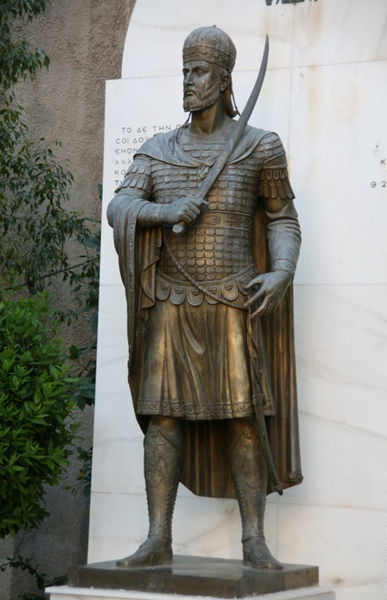Constantine XI, born in 1404, was the last reigning Byzantine Emperor, descending from the esteemed Palaiologos dynasty. Ascending to the throne in 1449, he ruled until the fall of Constantinople in 1453. Under his leadership, the Byzantine Empire faced its ultimate challenge as the Ottomans laid siege to its capital. Despite his valiant efforts, Constantine XI’s reign marked the end of an ancient empire that had lasted for over a millennium.
Struggle for Byzantine Survival
Under Constantine XI’s stewardship, the once-vast Byzantine Empire was continually besieged. By the time he took the throne, the empire was limited primarily to the city of Constantinople and a few regions in the Peloponnese. Constantine found himself under relentless pressure from the ascendant Ottoman Empire, which aimed to seize the legendary city and establish its supremacy in the region. Driven by an urge to protect his capital and people, Constantine devoted himself to reinforcing the city’s defenses, bolstering its walls, and bracing for an impending showdown.
Seeking Western Aid
Recognizing his inability to resist the Ottomans single-handedly, Constantine XI looked to the West for aid. Aiming to rally the Christian realm against the shared Ottoman menace, he endeavored to bridge the divide between the Eastern Orthodox and Roman Catholic Churches, a schism that had lasted almost four centuries. Through this, Constantine aspired to gain military and financial support from Rome and other Western Christian entities. The Union of Florence in 1439 marked a significant move toward this accord, yet many within his empire resisted this union, and tangible assistance from the West proved scarce. Despite these hurdles, Constantine’s pursuit of aid underscored the perilous state of his empire and his unyielding dedication to its defense.
The Heroic Defense and Martyrdom of Constantine XI
In contemporary Turkish series, documentaries, and various media outlets, Constantine XI is frequently depicted as a frail, malevolent, and negative figure, in stark contrast to Mehmed the Conqueror. However, such portrayals sharply deviate from the accounts presented in historical records. Far from the image of an indecisive ruler, Constantine XI was confronted with the formidable challenge of defending his capital against an overwhelmingly superior enemy. Given the options to flee or capitulate, he made the audacious choice to stand firm and lead the city’s defense against the might of the Ottomans.

Mehmed II, celebrated as Mehmed the Conqueror, had marshaled an imposing army of over 80,000 troops. In stark contrast, Constantine could gather less than 10,000 defenders. The odds were staggeringly in favor of the Ottomans. Yet, in these dire circumstances, Constantine rallied his forces with one of the medieval era’s most memorable speeches:
“You are aware that the infidels have unjustly broken our peace. They violated the oath and pact they pledged to us; they slaughtered our peasants amidst the harvest; they constructed a fort on the Propontis to engulf Christians; they laid siege to Galata during a truce. Now, they aspire to seize the city of Constantine the Great, your homeland, the haven that has perennially sheltered Christian refugees, the guardian of all Greeks. They menace to despoil our sacred churches, converting them into stalls for their horses and livestock. O, my brethren, my progeny, the everlasting honor of Christianity lies in your grasp. You, valiant Genoese, renowned for your myriad triumphs, who have perennially shielded this city in numerous skirmishes against the Turks, exhibit your valor, spirit, and mettle once again. And you Venetians, gallant fighters whose swords have repeatedly shed Turkish blood, who have lent us your strength and dispatched many an infidel to the ocean’s depths, led by Loredano, the most illustrious captain of our armada, who have endowed this city, treating it as if it were your own, with noble and exalted men, elevate yourselves further and brace for combat. Heed the directives of your chieftains, my comrades in arms, and recognize that this day is your day of splendor, the day when, by shedding even a speck of your blood, you shall attain eternal renown and the crowns of martyrs.”
Valorous allies, such as Giustiniani, demonstrated profound courage during the defense, commanding with fervor until a grievous wound necessitated his retreat. However, the overpowering numbers and relentless onslaught of the Ottomans eventually overwhelmed Constantinople’s storied defenses.

As detailed by Constantine Mihailović of Ostrovica, a somber episode transpired as the defenses crumbled. Constantine XI combated fiercely until his final moment amidst the debris. A Janissary by the name of Saneles decapitated him, offering the severed head of the emperor to Mehmed II, declaring it as the trophy of his most formidable adversary. After a detained close confidant of the emperor confirmed its identity, Mehmed lavished the Janissary with rewards, bestowing upon him the provinces of Aydin and Anatolia.
Legacy of Constantine XI
The tale of Constantine XI, his valiance, and his poignant demise is emblematic of the indomitable spirit of the last Byzantine emperor. Chronicling this legacy, Donald Nicol’s “The Immortal Emperor” emerges as one of the most evocative tributes to Constantine XI’s life and sacrifices, crafting a comprehensive and reverent depiction of a sovereign witnessing the demise of an ancient empire.

Historical Challenge: Can You Conquer the Past?
Answer more than 18 questions correctly, and you will win a copy of History Chronicles Magazine Vol 1! Take our interactive history quiz now and put your knowledge to the test!

